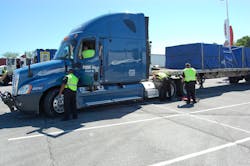The annual Brake Safety Week inspection campaign orchestrated by the Commercial Vehicle Safety Alliance (CVSA) kicks off this holiday weekend, so experts are sharing some insight into what roadside inspectors will be looking for when checking truck and trailer brakes.
“It’s easy to view preventive maintenance as a quick adjustment, grease job, and new brake pads, but there’s much more to it,” noted Kevin Pfost, technical service coordinator for Bendix Spicer Foundation Brake LLC. “Paying attention to a few key details during a routine brake job can have a major impact on keeping trucks on the road and in good working condition, reducing maintenance costs, and improving safety.”Staying on top of those key “details” is critical, he emphasized, as brake system health is a major focal point of year-round truck safety enforcement activity.
For example, during Roadcheck 2014 – the annual 72-hour safety enforcement “blitz” conducted across North America under the auspices of CVSA and the Federal Motor Carrier Safety Administration (FMCSA) -- brake adjustment, brake system, plus tire/wheel issues comprised the bulk of vehicle out-of-service (OOS) placements, with those three categories responsible for 61% of all OOS designations.
Though brake adjustment violations declined during Roadcheck 2014, falling to 16.7% from 19.5% in 2013 and 17.5% in 2012, overall brake system issues followed a more uneven path, dropping to 29.5% from 30.1% in 2013, though that’s higher than the 27.8% recorded during 2012’s three-day blitz.
That’s why, for this year’s Brake Safety Week campaign – running from Sept. 6 through 12 – focusing on a few key areas can help fleets keep their braking systems up to par:
The overall inspection game plan: Inspectors will follow a seven-point plan to guide their roadside checks next week:
- Driver’s license
- Registration
- Low air warning device
- Pushrod travel (adjustment)
- Brake linings/drums
- Leaks and air loss rate
- Tractor protection system
Note that in 10 jurisdictions across North America overall vehicle braking efficiency will be tested using performance-based brake testing (PBBT) equipment.
Eight specific brake system checks: Inspectors are going to focus on eight specific brake system features during their checks. Note, however, that several of them – specifically brake adjustment checks – can only be conducted if trucks and trailers use traditional S-cam “drum” brakes.
- Checking the air brake mechanical components
- Checking the steering axle air brake mechanical components
- Checking the brake adjustment
- Building the air system’s pressure to 90-100 psi
- Checking the antilock braking system (ABS) if applicable
- Testing the air loss rate, if necessary
- Testing the low air pressure warning device
- Checking the tractor protection system
Jon Morrison, president of the Americas for WABCO Holdings Inc., noted there’s a difference with air disc brakes (ADBs) as they do not need to be adjusted, thus eliminating the opportunity for a “brakes-out-of-adjustment” violation.
Clean air a must: Frank Gilboy, slack adjuster product manager with Bendix Spicer Foundation Brake LLC, stressed that maintaining a clean air system is a priority. “Components such as air seals, brake modulating valves, and brake chamber diaphragms are susceptible to premature damage if an air system is contaminated by moisture – and, in particular, oil,” he explained. “Deterioration of seals can cause air system leaks, which are targeted during Brake Safety Week inspections.”
Look for loose ends, leaks and cracks: During pre-trip inspections next week, at the wheel-ends, visually check that the air chambers are not damaged and hanging loose or with broken push rods, noted Bendix’s Gilboy. Check drum brakes for lining cracks, linings that may have been oil-saturated due to leaking wheel seals, and broken cam brackets, while for ADBs, check the rotors for cracks or grooving and make sure the caliper is sliding freely.
Say no to manual slack adjustment: Where automatic slack adjusters (ASAs), it’s important not to manually adjust them if the brakes are beyond the stroke limit. If 25% of a truck’s wheel-ends are beyond the maximum allowable brake stroke – in other words, out of adjustment – you are going to get fined. Bendix’s Gilboy said simple maintenance, such as greasing the slack, can keep the ASA working smoothly and in proper adjustment. Several factors – including improper lubrication of the camshaft, cam tube, and clevis pins; or excessive wear of the cam head, bushings, and rollers – can cause a brake stroke to exceed the maximum allowable value, but none of these will be fixed by manual readjustment of an automatic slack adjuster. “Last year’s Brake Safety Week saw about one in ten vehicles placed OOS for brake adjustment issues,” he stressed.
About the Author
Sean Kilcarr
Editor in Chief
Sean Kilcarr is a former longtime FleetOwner senior editor who wrote for the publication from 2000 to 2018. He served as editor-in-chief from 2017 to 2018.

